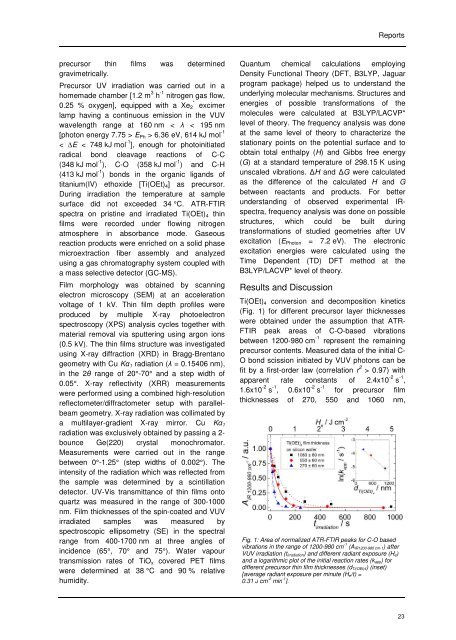Biennial Report 2016/2017
You also want an ePaper? Increase the reach of your titles
YUMPU automatically turns print PDFs into web optimized ePapers that Google loves.
<strong>Report</strong>s<br />
precursor thin films was determined<br />
gravimetrically.<br />
Precursor UV irradiation was carried out in a<br />
homemade chamber [1.2 m 3 h -1 nitrogen gas flow,<br />
*<br />
0.25 % oxygen], equipped with a Xe 2 excimer<br />
lamp having a continuous emission in the VUV<br />
wavelength range at 160 nm < λ < 195 nm<br />
[photon energy 7.75 > E Ph > 6.36 eV, 614 kJ mol -1<br />
< ȂE < 748 kJ mol -1 ], enough for photoinitiated<br />
radical bond cleavage reactions of C-C<br />
(348 kJ mol -1 ), C-O (358 kJ mol -1 ) and C-H<br />
(413 kJ mol -1 ) bonds in the organic ligands of<br />
titanium(IV) ethoxide [Ti(OEt) 4 ] as precursor.<br />
During irradiation the temperature at sample<br />
surface did not exceeded 34 °C. ATR-FTIR<br />
spectra on pristine and irradiated Ti(OEt) 4 thin<br />
films were recorded under flowing nitrogen<br />
atmosphere in absorbance mode. Gaseous<br />
reaction products were enriched on a solid phase<br />
microextraction fiber assembly and analyzed<br />
using a gas chromatography system coupled with<br />
a mass selective detector (GC-MS).<br />
Film morphology was obtained by scanning<br />
electron microscopy (SEM) at an acceleration<br />
voltage of 1 kV. Thin film depth profiles were<br />
produced by multiple X-ray photoelectron<br />
spectroscopy (XPS) analysis cycles together with<br />
material removal via sputtering using argon ions<br />
(0.5 kV). The thin films structure was investigated<br />
using X-ray diffraction (XRD) in Bragg-Brentano<br />
geometry with Cu Kα 1 radiation (λ = 0.15406 nm),<br />
in the 2θ range of 20°-70° and a step width of<br />
0.05°. X-ray reflectivity (XRR) measurements<br />
were performed using a combined high-resolution<br />
reflectometer/diffractometer setup with parallelbeam<br />
geometry. X-ray radiation was collimated by<br />
a multilayer-gradient X-ray mirror. Cu Kα 1<br />
radiation was exclusively obtained by passing a 2-<br />
bounce Ge(220) crystal monochromator.<br />
Measurements were carried out in the range<br />
between 0°-1.25° (step widths of 0.002°). The<br />
intensity of the radiation which was reflected from<br />
the sample was determined by a scintillation<br />
detector. UV-Vis transmittance of thin films onto<br />
quartz was measured in the range of 300-1000<br />
nm. Film thicknesses of the spin-coated and VUV<br />
irradiated samples was measured by<br />
spectroscopic ellipsometry (SE) in the spectral<br />
range from 400-1700 nm at three angles of<br />
incidence (65°, 70° and 75°). Water vapour<br />
transmission rates of TiO x covered PET films<br />
were determined at 38 °C and 90 % relative<br />
humidity.<br />
Quantum chemical calculations employing<br />
Density Functional Theory (DFT, B3LYP, Jaguar<br />
program package) helped us to understand the<br />
underlying molecular mechanisms. Structures and<br />
energies of possible transformations of the<br />
molecules were calculated at B3LYP/LACVP*<br />
level of theory. The frequency analysis was done<br />
at the same level of theory to characterize the<br />
stationary points on the potential surface and to<br />
obtain total enthalpy (H) and Gibbs free energy<br />
(G) at a standard temperature of 298.15 K using<br />
unscaled vibrations. ∆H and ∆G were calculated<br />
as the difference of the calculated H and G<br />
between reactants and products. For better<br />
understanding of observed experimental IRspectra,<br />
frequency analysis was done on possible<br />
structures, which could be built during<br />
transformations of studied geometries after UV<br />
excitation (E Photon = 7.2 eV). The electronic<br />
excitation energies were calculated using the<br />
Time Dependent (TD) DFT method at the<br />
B3LYP/LACVP* level of theory.<br />
Results and Discussion<br />
Ti(OEt) 4 conversion and decomposition kinetics<br />
(Fig. 1) for different precursor layer thicknesses<br />
were obtained under the assumption that ATR-<br />
FTIR peak areas of C-O-based vibrations<br />
between 1200-980 cm -1 represent the remaining<br />
precursor contents. Measured data of the initial C-<br />
O bond scission initiated by VUV photons can be<br />
fit by a first-order law (correlation r 2 > 0.97) with<br />
apparent rate constants of 2.4x10 -2 s -1 ,<br />
1.6x10 -2 s -1 , 0.6x10 -2 s -1 for precursor film<br />
thicknesses of 270, 550 and 1060 nm,<br />
Fig. 1: Area of normalized ATR-FTIR peaks for C-O based<br />
vibrations in the range of 1200-980 cm -1 (A IR1200-980 cm-1) after<br />
VUV irradiation (t irradiation) and different radiant exposure (H e)<br />
and a logarithmic plot of the initial reaction rates (k app) for<br />
different precursor thin film thicknesses (d Ti(OEt)4) (inset)<br />
[average radiant exposure per minute (H e/t) =<br />
0.31 J cm -2 min -1 ].<br />
23


